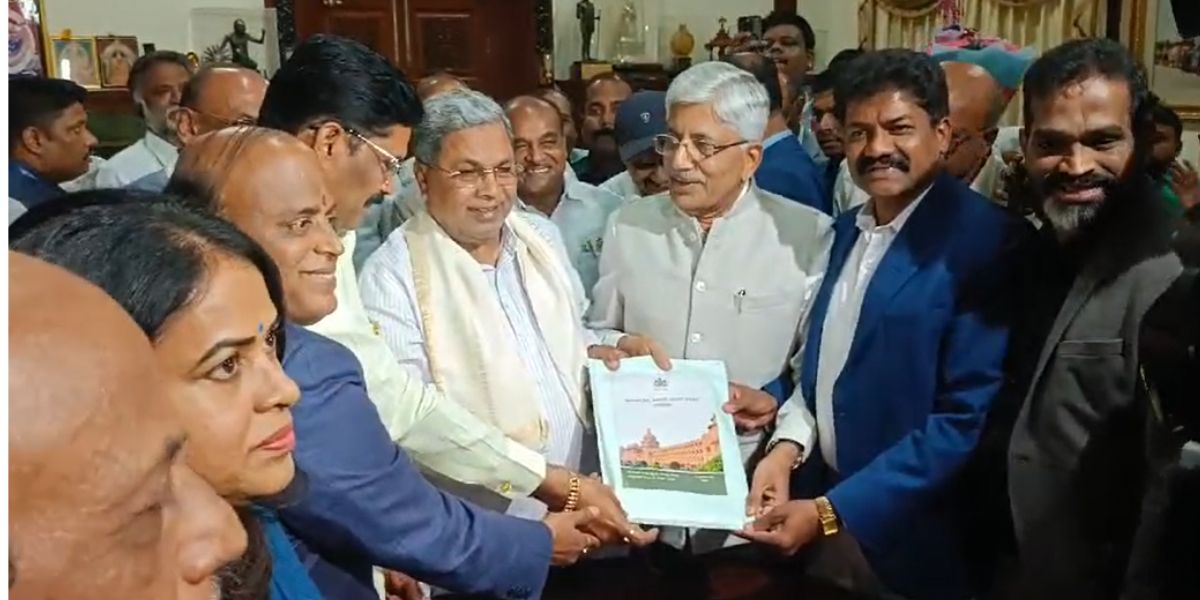Chief Minister Siddaramaiah is caught between two strong social groups over the issue and he cannot antagonize either.

Jayaprakash Hegde submitting caste census report to CM Siddaramaiah.
The Congress-ruled Karnataka government appears caught in a cleft stick over the caste census. Jayaprakash Hegde, Chairman of the Karnataka State Commission for Backward Classes, submitted the report to Chief Minister Siddaramaiah on 29 February 29, 2024, the last day of his tenure. If accepted and implemented, the report threatens to be a disruptive element in the state’s `settled’ social order.
There are enough indications that the report, titled Karnataka State Socio-Economic and Education Survey, or caste census in popular terms, may become a hot potato for the Congress. While the government has refrained from commenting on the report, leaks in the media about its contents have already created ripples among the dominant castes in the state.
These leaks have kept the population of politically strong communities like the Lingayats and Vokkaligas at a number far less than presumed. Thus, the carefully crafted perception that these dominant castes are also numerically strong goes for a toss, hence their opposition to the caste census. But not just this. The report is said to have put the number of Scheduled Castes and Muslims ahead of Lingayats and Vokkaligas. This is another reason these two castes cry wolf over the report.
This is the crux: The two dominant groups—also joined by the numerically weak Brahmins—raise a banner of revolt against the report. As against this stand of these strong communities, the `Ahinda’ group—Kannada acronym for minorities, backwards, and Dalits—has demanded that the government accept the report forthwith and implement the recommendations.
The dates of the Lok Sabha elections are out, and the report has put Congress in a Catch-22 situation—it can neither go against the dominant castes nor face the wrath of the Ahinda sections. For now, Siddaramaiah has played it safe by merely saying that a cabinet subcommittee will look into the report’s contents.
Such is the virulent opposition that senior-most Congress MLA Shyamanur Shivashankarappa has said the report, “prepared ten years ago, should be thrown into the dustbin”. He added that the community’s All India Veerashiava Mahasabha will survey the Lingayats to determine their population.
The 93-year-old Congress leader recently created rumblings within the party by calling upon the voters of the Shivamogga Lok Sabha constituency to re-elect BJP’s B Y Raghavendra, son of former chief minister B S Yediyurappa. Of course, Congress could not dare take action against the Lingayat strongman whose family members have been dominating the political scene of the Davanagere district.
The opposition to the report grew stronger as the powerful Lingayat mutts came together and said they would not allow it to be implemented. The Lingayats, Vokkaligas, and Brahmins have said they will launch a joint state-wide agitation if the government accepts the report.
The Vokkaligas’ joining hands with the Lingayats to oppose the report—generally, the two are seen as rivals—puts the government in an unenviable position. The two, if combined, can rustle up a powerful force anywhere—especially in the government. Consider this: Of the 33 ministers in the state, 13 belong to these two powerful communities; 44 Vokkalligas and 37 Lingayats were elected from Congress out of its total strength of 135. Of the 22 CMs that Karnataka has had since the formation of the state, 15 were from these communities.
Also, the Lingayat vote matters in about 90 seats and Vokkaligas’ in about 80 seats. This shows the two groups’ dominant role in nearly every sphere of the state. The MLAs belonging to both castes – Deputy CM D K Shiv Kumar is a Vokkaliga – have opposed the caste census report.
Pitted against them, regarding the caste census, is the Ahinda group, which thinks the report gives a realistic picture and hence wants its implementation. Siddaramaiah is seen as the leader of the Ahinda group, and it supported Congress in the 2023 assembly elections.
Dalits have already pledged their support to the party in the 2024 Lok Sabha polls in the state. Various Dalit groups held a meeting in February 2024 and decided to support it. In the 2023 polls, Congress won 21 of the 36 SC reserved seats while BJP could win only 12. The saffron outfit could not win any of the 15 ST seats – Congress won 14.
Let us examine the leaked numbers of the report: the census pegs the total state population at 5.98 crore (as against the 6.1 crore per the 2011 census). It puts the population of the SCs at 1.08 crore, Muslims at 70 lakh, Lingayats at 65 lakh, Vokkaligas at 60 lakh etc. The Ahinda group would be about 3.98 crores, and that of the Lingayats, Vokkaligas, Brahmins, and other castes would be 1.87 crores. Lingayats claim their number is much higher at 1.2 crore or 17% of the population than Vokkaligas, 1.05 crore or 15%.
The two communities matter a lot in each of the state’s 28 Lok Sabha constituencies, including in five SC and two ST reserved seats. Thus, the ruling party knows too well that it cannot antagonize these two groups before the elections. However, Siddaramaiah may favour accepting the report or at least making it public. He knows the costs involved.
At the same time, he needs to face the Ahinda groups, which want the report implemented, although they have not gone on a warpath over it. But they may well agitate if the government drags its feet on the issue. On both counts, Siddaramaiah knows that he must walk a tightrope and tread carefully.
(The writer is a Bengaluru-based senior journalist)

May 05, 2024

May 04, 2024

May 04, 2024

May 03, 2024

Apr 29, 2024

Apr 28, 2024